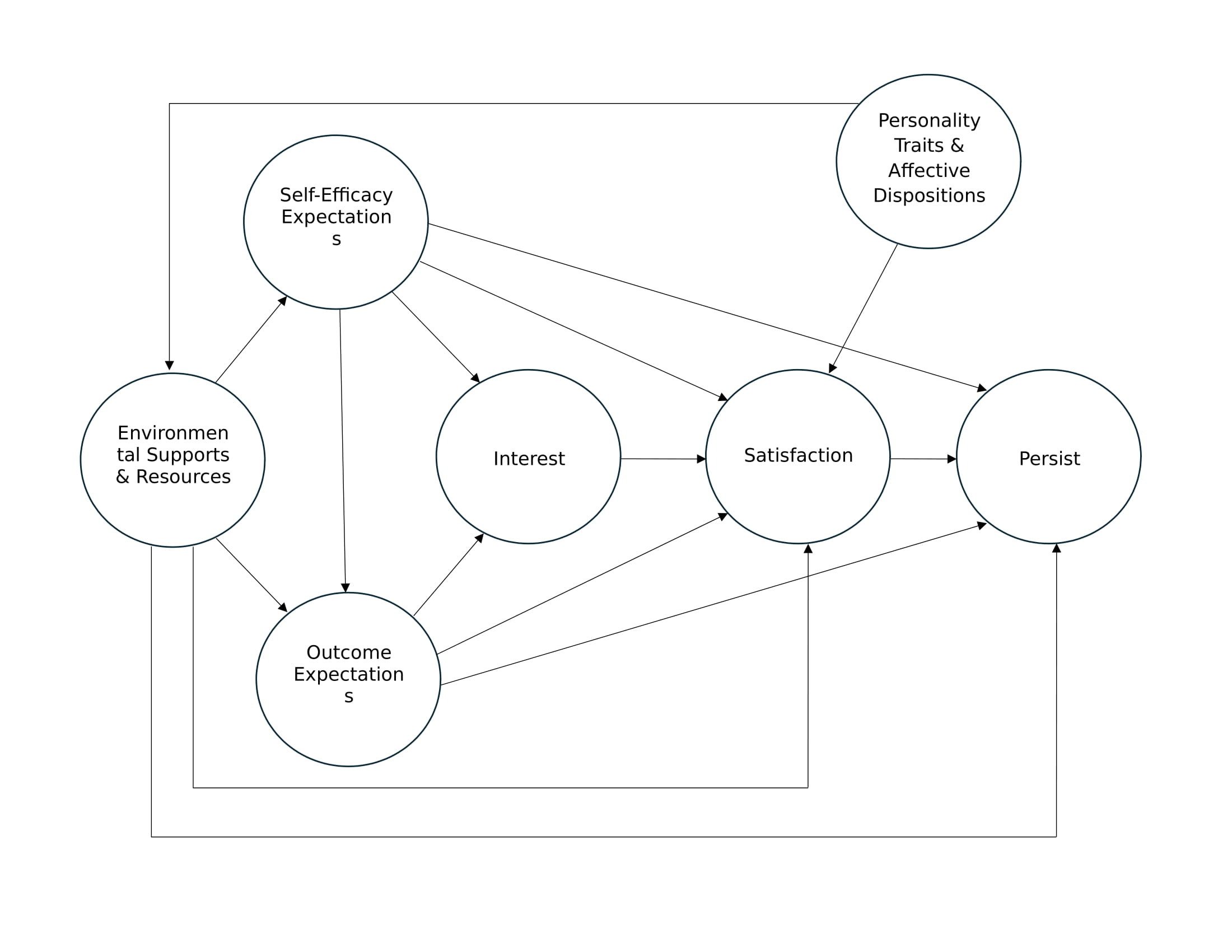
The purpose of the STEM Self-Efficacy Propagation Group is to explore ways to use current PROSPECT findings and observations, as well as additional data collection, to learn about the phenomena that are associated with student self-efficacy in STEM. The proposed framework for organizing this exploration was Social Cognitive Career Theory (SCCT) as presented in Lent et al. (2013). SCCT has been used to explain various factors in STEM career interest, satisfaction, and persistence. Broad categories of factors in the framework are environmental supports and resources, self-efficacy expectations, outcome expectations, and personality traits and affective dispositions (see Figure 1).
The group began discussing the topic in February 2025 and quickly decided to share instruments used at group members’ sites to collect data related to self-efficacy. In addition, the group agreed that an important step would be to operationally define STEM self-efficacy, particularly regarding transfer students.
In March, the group took up the task of operationally defining STEM self-efficacy with an in-depth, wide-ranging discussion. Members from the University of Missouri-Kansas City (UMKC) and the University of North Carolina at Greensboro (UNCG) reported observing few significant results with the measures they shared with the group. The group identified several possible explanations, including: (a) a mismatch between the time between measurements and the time required for change in self-efficacy to occur; (b) assuming a single application of an intervention was sufficient to cause change when repeated applications might be required; (c) assuming that growth in self-efficacy is linear rather than nonlinear; and (d) assuming that STEM self-efficacy is unidimensional rather than multidimensional. All of these factors need to be considered when operationally defining STEM self-efficacy. An additional consideration identified was the intended use of a STEM self-efficacy scale, which the group clarified as observing and comparing gains in STEM self-efficacy.
In further discussion, it was revealed that UNCG had observed greater gains in first-time college students than transfer students, which parked conversation about possibly designing different measures for pre- and post-transfer students. The group’s discussion coalesced on distinguishing between self-efficacy to complete a STEM degree (and perhaps different measures for associate’s and bachelor’s) STEM self-efficacy in general.
In April, the group agreed to brainstorm attributes that characterize STEM self-efficacy, basing them either in theory or extant measurement instruments, so there would be a basis for identifying items already in use by the group or attributes needing items to be created. Later in May, the group discussed a first draft of a table of specifications (TOS). In scale development, a TOS is comprised of columns representing attributes of the construct to be measured and rows representing the items in the scale. The TOS helps the scale developer assess the content validity of the scale by highlighting attributes that are over- or underrepresented by the items, or not represented at all. It also helps identify items that are unnecessary (i.e., that do not represent an attribute of the construct). The draft TOS was based on the items shared by UMKC and UNCG, and the group recognized many gaps in the content coverage of STEM self-efficacy. (It should be noted that neither UMKC nor UNCG intended to measure STEM self-efficacy with their instruments.) This sparked much discussion about overlap between STEM self-efficacy and other STEM-related constructs, such as identity, motivation, and belonging.
The group agreed to continue working through the summer and is currently organizing a regular meeting time. Current tasks include adding to the TOS and collecting and sharing relevant literature and instruments. The long term goal is to develop a STEM self-efficacy scale either using currently used items, newly created items, or a mix of both, by the fall semester. Depending on what is created, the group will either collect data or use archival data from group members’ sites. If you are interested in joining the group, fell free to contact Jake Marszalek at marszalekj@umkc.edu.
References
Lent, R. W., Miller, M. J., Smith, P. E., Watford, B. A., Lim., R., H., Hui, K., Morrison, M. A., Wilkins, G., & Williams, K. (2013). Social cognitive predictors of adjustment to engineering majors across gender and race/ethnicity. Journal of Vocational Behavior, 83(1), 22-30. https://doi.org/10.1016/j.jvb.2013.02.006
Article contributed by Jacob Marszalek, Interim Associate Dean of Education at the University of Missouri-Kansas City.